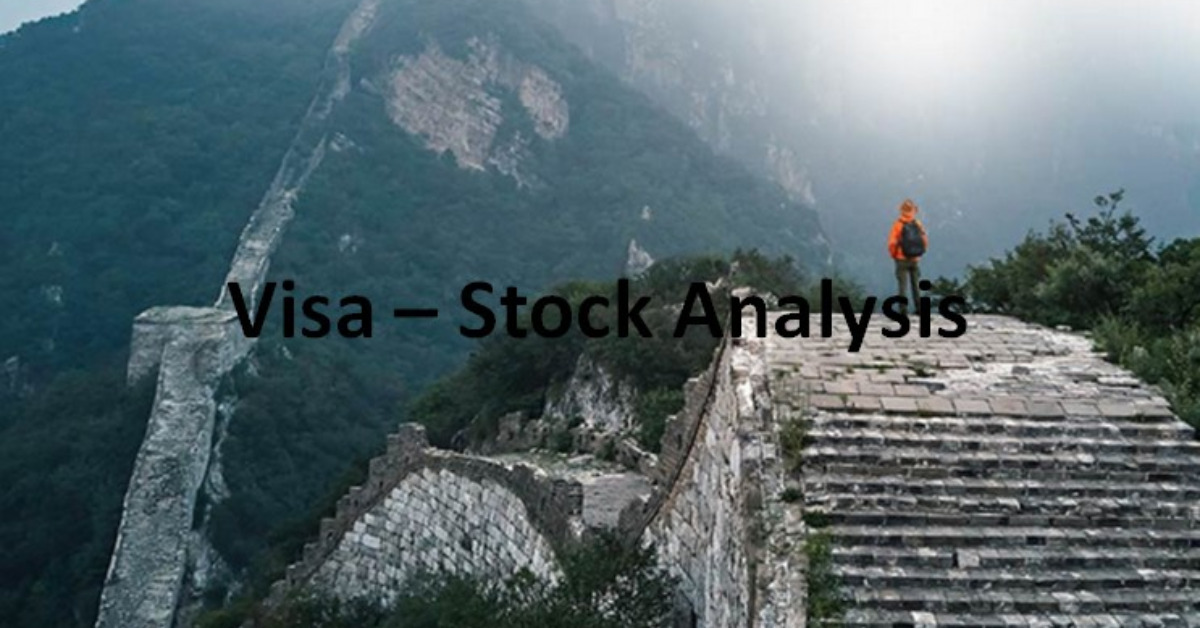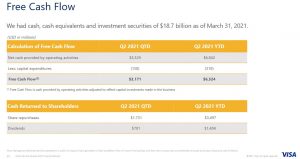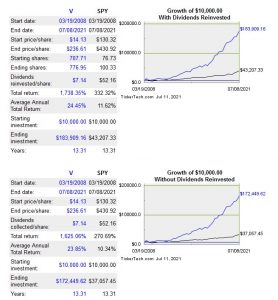Contents
In this Visa stock analysis I:
- disclose my July 12th purchase of 100 additional Visa shares; and
- provide an update on the status of the $250 July 16 2021 covered call option contracts I disclosed in my May 26th Visa - Options Trade Review post.
V is our largest holding (FFJ Portfolio Holdings Review: April 2021). The majority of shares are in a retirement account for which I do not disclose details.
Visa - Stock Analysis - Financials
Q2 and YTD 2021 Results
There is little point in reviewing Q2 results since V is releasing Q3 2021 results on July 27. If interested, however, the Q2 Earnings Release and accompanying Investor Presentation are accessible here and the Q2 10-Q is accessible here.
Visa - Options - July 16, 2021 Expiry
On May 26, 2021, I wrote multiple V option contracts and received ~$90.10/options contract (nominal transaction costs excluded).
I expect V's results to show a marked improvement from the 2nd half of FY2020 and YTD 2021 results as the global economy slowly reopens and business conditions in various hard-hit business sectors gradually return to 'normal'.
V's share price may be bid up as we approach the July 27th Q3 earnings release. Hopefully, the share price will remain below $250 between now and July 16th so the option contracts expire and I can retain 100% of the option premium and the underlying shares.
Visa - Stock Analysis - Credit Ratings
Many investors appear to give little consideration to risk. I often see investors in various Facebook groups or on YouTube, discussing investments where the company's domestic senior unsecured credit ratings are 'non-investment grade speculative' or 'highly speculative'. These are DEBT ratings. Holding common shares carries far greater risk!
Moody's currently rates V's domestic senior unsecured long-term debt Aa3 and S&P Global rates it AA-.
Both ratings are the bottom tier of the 'high-grade' investment-grade category. Investors can take comfort that V has a VERY STRONG capacity to meet its financial commitments with its ratings differing only to a small degree from the highest-rated obligors.
Dividend and Dividend Yield
Many investors focus on generating dividend income and overlook V as a potential investment because of its sub 1% dividend yield. The dividend yield is not my focus. I look at an investment's potential overall return.
I initiated a V position shortly after its IPO and the following shows the extent to which V has outperformed the S&P500 over ~13.3 years; past performance has little bearing on future performance but I am confident V will continue to perform admirably going forward.
V will very likely declare its 4th consecutive $0.32 quarterly dividend near the end of July 2021; the dividend yield is ~0.54% based on the current ~$238.50 share price.
In late October, I expect a ~$0.34 quarterly dividend; V will have no difficulty in servicing this higher dividend since it generates ample operating cash flow and free cash flow.
V has 3 classes of shares (Class A, B, and C) but the Class A shares are what retail investors buy/sell.
The weighted average number of Class A outstanding shares in FY2011 - 2020 (in millions) is: 2,828, 2,712, 2,624, 2,523, 2,457, 2,414, 2,395, 2,329, 2,272, and 2,223 with 2,196 for the 6 months ending March 31, 2021.
Visa - Stock Analysis - Valuation
When I wrote $260 June 18, 2021 options contracts, $5.80 was the high end of FY2021 adjusted diluted EPS guidance from 41 brokers. Using $5.80 and the $220 share price at the time of the trade, the forward adjusted diluted PE was ~37.93.
When I wrote the $250 July 16, 2021 options contracts, the guidance was unchanged. Shares were trading at ~$228 and the forward adjusted diluted PE was ~39.31.
Shares now trade at ~$238.50 and the mean adjusted diluted EPS and low/high guidance are $5.62 and $5.12 - $5.85 from 41 brokers. Since V is releasing Q3 results before July month-end, I am taking into consideration FY2022 adjusted diluted EPS guidance as part of my 'valuation' determination.
The mean and low/high adjusted diluted EPS guidance from 41 brokers is $7.05 and $6.40 - $7.81. Using the current ~$238.50 share price and the mean estimate, the forward adjusted diluted PE is ~33.83.
As the global economy reopens, I think V's FY2022 adjusted diluted EPS will approach the top end of estimates. If V were to generate $7.70, for example, the adjusted diluted PE could end up in the ~29 - ~31 range. This valuation is a bit rich but in V we have:
- a company with a commanding market share in a scalable industry;
- plenty of growth opportunities; and
- a scalable business that should result in an improvement in impressive margins (Operating Margin in the mid-60s).
Visa - Stock Analysis - Final Thoughts
V is my largest holding and I have no qualms about increasing my exposure. Despite V's current valuation being somewhat higher than I prefer, I acquired an additional 100 shares in a taxable account on July 12th. I also intend to acquire additional shares if we get a long-overdue broad market correction and V's share price is caught in the downdraft.
My dilemma is that we hold the majority of our V shares in a retirement account; I want to build our V position within taxable accounts as part of our intergenerational transfer of wealth strategy.
We must withdraw funds from our Registered Retirement Savings Plan (RRSPs) accounts over the next several years before we reach the age of 71; this is the mandatory age at which RRSPs must convert to a Registered Retirement Income Fund (RRIF). If we do not 'meltdown' our RRSPs, our minimum mandatory RRIF withdrawals will be at the highest marginal tax rate. The plan is to let the V shares to grow tax-free in the RRSPs until we must sell them to meet the mandatory annual RRIF withdrawals and to sell other holdings as part of our 'meltdown' strategy.
Stay safe. Stay focused.
I wish you much success on your journey to financial freedom!
Note: Please send any feedback, corrections, or questions to [email protected].
Disclosure: I am long V.
Disclaimer: I do not know your individual circumstances and do not provide individualized advice or recommendations. I encourage you to make investment decisions by conducting your own research and due diligence. Consult your financial advisor about your specific situation.




